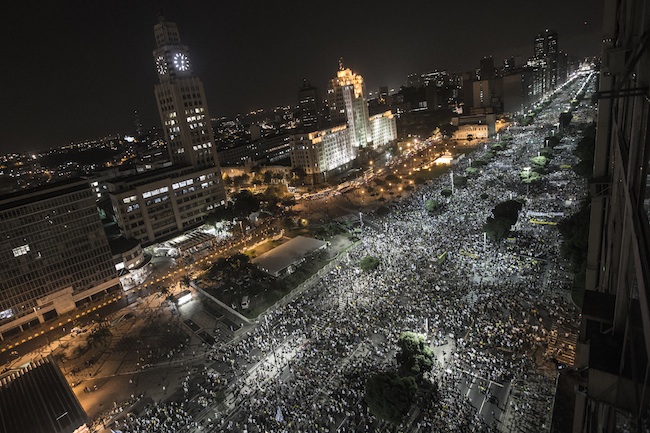SUMMARY
This is AI generated summarization, which may have errors. For context, always refer to the full article.

RIO DE JANEIRO, Brazil – About a million people took to the streets of 100 Brazilian cities as their protests against corruption and social and economic injustice saw their first death.
Violence broke out in more than 10 cities late Thursday, June 20, and early Friday, June 21, and an 18-year-old man was killed and three people injured when they were hit by a car trying to drive around a protester-erected barricade in Ribeirao Preto, 300 kilometers north of Sao Paolo.
Hundreds of people were injured as the initially peaceful protests were interrupted by clashes as some protesters threw stones and police fired rubber bullets and tear gas to disperse them in a number of cities.
The demonstrations are the largest Brazil has seen in two decades.
President Dilma Rousseff postponed a trip she had planned to Japan and called an emergency meeting Friday morning in Brasilia. Justice Minister Jose Eduardo Cardozo, who has been criticized for the security forces’ response to the demonstrations, was to attend.
The largest demonstration of the night was in Rio de Janeiro, where 300,000 people turned out. Most of them demonstrated peacefully as they marched in the centre of the city towards the mayor’s office.
The situation escalated, however, as the police fired tear gas grenades. Clashes broke out, and rioters set fire to cars and plastic awnings and ripped up fences.
Police on horseback and in armored vehicles were deployed to fight back the protesters.
“The police completely lost control and are incapable of dealing with such demonstrations,” said a television station employee who was hit in the head by a rubber bullet.
Clashes occurred in at least 10 other cities, including the capital, Brasilia, where 30,000 people marched through the government quarter. Police there also fired tear gas and rubber bullets.
Thousands moved towards the Foreign Ministry and built a large fire outside it.
More than 100,000 people took to the streets in Sao Paulo, Brazil’s largest city, where the protests were largely peaceful.
In Ribeirao Preto, the driver of the Land Rover that hit the 4 people drove away from the scene without stopping, media reports said.
One of the injured was in a serious condition, they said.
The protests began more than a week ago against a hike in public transport fares but have broadened, taking on corruption and the costs of hosting the Confederations Cup, which is currently being played; the 2014 World Cup; and 2016 Olympics.
The protesters argued that the money for the sporting events should have instead been invested in education, health care and other social programs.
The crowds grew despite a rollback of the transport fare hike being announced Wednesday, June 19.
“Corruption is the central issue, and we are dealing here with a national movement,” historian Francisco Carlos Teixeira said.
Heavy clashes occurred at an intersection in Campinas near Sao Paulo between police and protesters. In Salvador in Bahia state, where Confederations Cup matches were played Thursday, rioters set a bus on fire and damaged two mini-buses belonging to football’s world governing body, FIFA. – Rappler.com
Add a comment
How does this make you feel?
There are no comments yet. Add your comment to start the conversation.